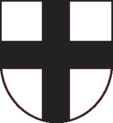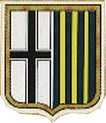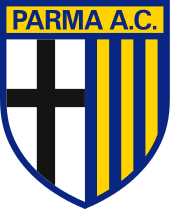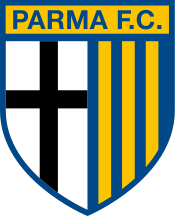Parma F.C. strip
This article describes the evolution of the Parma F.C. strip over the years.
Parma Football Club, commonly referred to simply as Parma, is an Italian professional football club founded in 1913 and based in Parma, Emilia–Romagna. Parma currently play in Serie A.
Colours
In the 1980s, when replica kits first became available - so-called because they are cheaper and more hard-wearing than the authentic clothing worn by the players - it was common for new kits to be released every couple of years. However, it is now increasingly common for new home and change kits to be released every season, generally played from August to May or June in Italy. Indeed, this has been Parma's practice since the turn of the millennium with the exception of a shirt worn from the summer of 2004 to the early part of 2006 when the club was in dire financial straits. New 2005–06 shirts were eventually released, but were only worn for four months before a slightly modified set was released in time for the 2006–07 season. Away kits now follow much the same pattern with a new away and third kit released each summer. Exceptionally, as in both 2010–11 and 2011–12, a fourth shirt will be released. This frequent changing of shirts can be the cause of consternation from fans who buy the replicas.[1]
Home colours
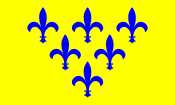
For much of Parma's history, the home colours have been white shirts with a black cross and black shorts and socks and this was the case from the club's foundation in 1913 until 1951.[2] For much of the 1950s, in combination with white, the club introduced yellow and blue onto the kit in honour of the city's traditional colours, which date back to the 1545 establishment of the Duchy of Parma.[3][4] For a decade from 1983, the team wore plain white shirts with blue and yellow pinstripes covering the sleeves when playing at home, but moved to a plainer all-white outfit until 1998. Quartered yellow and blue shirts were worn many years ago, but whether these were home or away shirts is unclear.[5]
In 1998, the club reverted to the city colours of blue and yellow, wearing them in various horizontal hooped shirts for six seasons until 2004. Because this was a time of great success for the club, the shirts have become synonymous with Parma and the club are still referred to with reference to this period as the Gialloblu (Yellow and Blues) today. This is despite the 2004 reversion to the traditional white shirts emblazoned with a cross, dark blue in three seasons between 2004 and 2007 but black since. The catalyst for the change from yellow and blue to white was the club's re-foundation and renaming from Parma Associazione Calcio to Parma Football Club after Parmalat's financial meltdown. Some fans would prefer a return to the yellow and blue hoops which were worn in Parma's most successful years and are different from the colours worn by the club towards which supporters of Parma hold most animosity – Juventus.[6] The colour of the shorts and socks have matched in recent years, but whether black or white has been chosen has varied. For the club's centenary season in 2013–14, the horizontal element of the cross continued around to the back of the shirt, as was the case from the club's inception in 1913 until the 1940s.[7] It also released a throwback shirt for its centenary match, worn only on 15 December 2013.
|
Verdi F.B.C. 1913 |
|
1920s |
|
1952–53[8] |
|
1953–54[8] |
|
1954–55[9] |
|
1958–59[8] |
|
1968–69[8] |
|
1978–83[15] |
|
1983–92[16] |
|
1992-93 |
|
1993–95 |
|
1995-97 |
|
1997–98 |
|
1998-99[17] |
|
1999-00 |
|
2000–01[18] |
|
2001–03[18] |
|
2003–04[18] |
|
2004–05[18] |
|
2005–06[18] |
|
2006[18] |
|
2006–07[18] |
|
2007–08[19] |
|
2008–09[20] |
|
2009–10[19] |
|
2010–11[19] |
|
2011–12[19] |
|
2012–13[19] |
|
2013–14[19] |
|
15 Dec 2013 |
Change colours
Over the years, Parma's change colours have often featured yellow and blue. The team's second colours were blue for most of the 1980s and the early 1990s,[21] but blue then became the club's third kit colours as the decade progressed (with the exception of the adoption of a copper shirt in 1996–97) and yellow was worn in preference as the second choice kit until 1997, when blue became the away kit again. From 1998 until 2004, the away kit was all white, while the third kit varied was dark blue when used. In 2004, Parma's away and third kits began to feature yellow and blue after the return of the white kit to the home shirt. As part of the crossover the 2003–04 home shirt was worn as an away shirt for 2004–05 and 2005–06. After this, the away and third shirts featured crosses in combinations of blue and yellow for two years before the 2008 introduction of blue and yellow vertically striped shirts, which echo the 1957–58 versions.[4] In 2010, a blue shirt with yellow sleeves (similar to the shirt used between 1953 and 1957[9]) and a grey shirt with two horizontal blue hoops outlining a single yellow hoop (re-creating the 1954–55 shirt, but replacing white with grey[9]) were unveiled to be worn as away and third kits, respectively. While the black away kit unveiled in 2011 was an unusual affair, the year's third and fourth kits brought back memories of the yellow and blue home shirts of the some of the club's most successful seasons; as did the 2012–13 away kit.[22] The away shirt for the club's centenary year in 2013–14 was a reproduction of the quartered yellow and blue design worn by the embryonic form of the club, Verdi F.B.C., in 1913.[23]
|
Away
1920s |
|
Away
1953–58[9] |
|
Away
1976–77[24] |
|
Away
1987–88[27] |
|
Away
1992-93[28] |
|
Third
1995-96[33] |
|
Third
1996-97[34] |
|
Away
1997–98[35] |
|
Away
1998-99[36] |
|
Third
1998-99[37] |
|
Away
1999-00[38] |
|
Third
1999-00[39] |
|
Away
2001–03[18] |
|
Away
2003–04[18] |
|
Away
2004–06[18] |
|
Away
2006[18] |
|
Third
2006[18] |
|
Away
2006–07[18] |
|
Third
2006–07[18] |
|
Fourth
2006–07[18] |
|
Away
2007–08[19] |
|
Third
2007–08 |
|
Away
2008-09 |
|
Away
2009–10[19] |
|
Third
2009–10[19] |
|
Fourth
2009–10 |
|
Away
2010–11[19] |
|
Third
2010–11[19] |
|
Pre-season
2010–11[19] |
|
Away
2011–12[19] |
|
Third
2011–12[19] |
|
Fourth
2011–12 |
|
Away
2012–13[19] |
|
Third
2012–13[19] |
|
Away
2013–14[19] |
|
Third
2013–14[19] |
Shirt badge
The badge of Verdi Foot Ball Club was a simple chequerboard pattern incorporating the city colours.[40] Parma Foot Ball Club used the cross seen on today's kits, before A.S. Parma adopted a badge more similar to today's in 1930.[40] Parmense, the club with which the modern day Parma came from, wore a very different crest, although it did still use the city colours of yellow and blue. The badge adopted in 1968 larged reproduced the post-1930 badge and today's badge that most recently changed in 2005 due to the name change from Parma Associazione Calcio to Parma Football Club, although the pre-2005 and post-2005 badges bear no significant differences, except for the replacement of the 'A' with an 'F' and the use of a slightly lighter hue of blue in the new badge. Only once in recent years has there been significant deviation from the traditional style that is currently in use. The one season for which the badge was changed, the 2000–01 season, saw the generation of much criticism for the new logo, which featured a prancing bull and was consequently used for just one season.[41] Parma wore a badge for its centenary season in 2013–14.
|
|
|
|
|
|
|
|
|
|
|
|
|
|
|
|
|
|
Sponsorship

Parma has had its kits manufactured by and sponsored by a variety of companies since 1981, including parent company Parmalat for a period of eight years.[3] Its kits are presently manufactured by the global Erreà sportswear brand, which pays the club €1.1M per annum and whose origins are in Torrile, approximately 13 kilometres north of Parma. That arrangement has been place since 2006, when it replaced previous manufacturer Champion, and will run until 2015 pursuant to an agreement signed in May 2011.[42] The club's principal sponsor is German household retail group Vorwerk, which signed a 2-year deal in 2012 to replace clothing retailer Navigare's €1.7M per annum deal.[43] Navigare appears on the side's shirts as the secondary kit sponsor.
| Period | Kit manufacturer | Shirt sponsor |
|---|---|---|
| 1981–87 | Umbro | Prosciutto Parma |
| 1987–95 | Parmalat | |
| 1995–98 | Puma | |
| 1998–99 | Lotto | |
| 1999–00 | Champion | |
| 2000–01 | Parmalat, Mr Day | |
| 2001–02 | Joy, Parmalat, Santal | |
| 2002–03 | Parmalat, Santal | |
| 2003–04 | Parmalat, Santal, Cariparma | |
| 2004–05 | Champion | |
| 2005–06 | Champion, Erreà | Fidenza Village, ABO Project, Tecnocasa, Silver Cross |
| 2006–07 | Erreà | Gimoka, Play Radio |
| 2007–08 | Kome, Il Granchio, Gondolino, Coreggio | |
| 2008–09 | Banca Monte Parma, Metella | |
| 2009–12 | Navigare, Banca Monte Parma | |
| 2012–14 | Vorwerk Folletto, Navigare | |
Numbers
Persistent squad numbers
In 1995, Italian football switched to persistent squad numbers, abandoning the mandatory use of 1–11 for the starting line-up. Persistent squad numbering became standard in Serie A at the start of the 1995–96 season in August, along with names printed above the numbers, and in European competition the following season. The practice followed the model adopted by the Premier League in England two years earlier and most European top leagues have since adopted a similar system.
Retired numbers
In a not uncommon practice, the number 12 shirt has been reserved for the Parma fans. As a consequence, no player is currently registered to play with that number on his kit for the club. The implication is that the supporters, particularly those who sit in the Curva Nord in Parma's home stadium – the Stadio Ennio Tardini – are the twelfth man. The last player to be registered with the number was Gabriele Giroli for the 2002–2003 season.
References
- ↑ Magowan, Alistair (26 July 2010). "Fans hit out at increased kit changes by clubs". BBC Sport (bbc.co.uk). Retrieved 16 August 2011.
- ↑ 2.0 2.1 "L’emozione di Piero Convalle e Pietro Giuberti, Crociati anni Cinquanta, che stanno raggruppando gli ex Parma Calcio per la festa del 99° Compleanno di domenica all’Ennio" [The emotions of Piero Convalle and Pietro Giuberti, 50th year Crociati, ex Parma players who will brought together for the 99th birthday on Sunday at the Tardini]. SettoreCrociatoParma.it. 11 December 2012.
- ↑ 3.0 3.1 "Heraldry in Pre-Unification Italy". Heraldica. Retrieved 30 July 2010.
- ↑ 4.0 4.1 "Indiscrezioni sulle nuove maglie del Parma FC 2009-2010" [Rumours on Parma's new 2009-10 kit]. 22 July 2009.
- ↑ "Fotocronache Crociate". Settore Crociato Parma.
- ↑ "Comitato per la maglia gialloblu a strisce orizzontali" [Campaign for the kit with horizontal yellow and blue stripes]. goal.com. Retrieved 11 March 2011.
- ↑ "La descrizione della Maglia Crociata per la stagione del Centenario, che riprenderà quella disegnata nel 1913 da Ugo Betti" [Description of the cross shirt for the centenary season, which returns to the Ugo Betti's 1913 design]. SettoreCrociatoParma.it/. 29 May 2013.
- ↑ 8.0 8.1 8.2 8.3 8.4 "Le Formazione della Storia" [The Formation of History]. Settore Crociato Parma. Retrieved 28 April 2011.
- ↑ 9.0 9.1 9.2 9.3 "Pescate dalla storia le tre nuove maglie del Parma 2010-2011" [The three new Parma shirts drawn from history]. 4 August 2010.
- ↑ "Stagione 1971/72 - Serie C". Storia del Parma Calcio.
- ↑ "UDINESE - PARMA 0 - 2". Settore Crociato Parma. Retrieved 28 April 2011.
- ↑ "Figurine Crociate: Anno 1973–1974". Settore Crociato Parma. Retrieved 28 April 2011.
- ↑ "Figurine Crociate: Anno 1974–1975". Settore Crociato Parma. Retrieved 28 April 2011.
- ↑ "Figurine Crociate: Anno 1977–1978". Settore Crociato Parma. Retrieved 28 April 2011.
- ↑ "Triesta-Parma". Settore Crociato Parma. Retrieved 28 April 2011.
- ↑ "Speciale – Modena–Parma". Settore Crociato Parma. Retrieved 28 April 2011.
- ↑ "Stagione 1997-98".
- ↑ 18.0 18.1 18.2 18.3 18.4 18.5 18.6 18.7 18.8 18.9 18.10 18.11 18.12 18.13 18.14 "Parma 1". Retrieved 15 July 2011.
- ↑ 19.0 19.1 19.2 19.3 19.4 19.5 19.6 19.7 19.8 19.9 19.10 19.11 19.12 19.13 19.14 19.15 19.16 19.17 "Parma 1". Retrieved 7 December 2012.
- ↑ "2008-09". Retrieved 16 January 2014.
- ↑ "VICENZA - PARMA: 1 - 4". Settore Crociato Parma. Retrieved 28 April 2011.
- ↑ "Le nuove maglie del Parma presentate tra i tifosi a Ravadese" [The new Parma shirts presented to the fans at Ravadese]. 10 July 2011.
- ↑ "La seconda Maglia del Centenario: a scacchi gialli e blu, come quella del Verdi Fbc" [The second shirt of the centenary: quartered in yellow and blue like Verdi F.B.C.]. SettoreCrociatoParma.it/. 3 June 2013.
- ↑ "Figurine Crociate: Anno 1976–1977". Settore Crociato Parma.
- ↑ "Perani parte alla grande, po rallenta, prima del rush finale che riporta la squadra in Serie B". Storia del Parma Calcio.
- ↑ "1984–85". Storia del Parma Calcio.
- ↑ "Stagione 1987/1988 - Serie B". Storia del Parma Calcio.
- ↑ "Stagione 1992-93".
- ↑ "Stagione 1993-94".
- ↑ "Stagione 1994-95".
- ↑ "Stagione 1995-96".
- ↑ "Stagione 1996-97".
- ↑ "Stagione 1995-96".
- ↑ "Stagione 1996-97".
- ↑ "Stagione 1997-98".
- ↑ "Stagione 1998-99".
- ↑ "Stagione 1998-99".
- ↑ "Stagione 1999-00".
- ↑ "Stagione 1999-00".
- ↑ 40.0 40.1 "Historia Herbu" [Logo History] (in Polish). Retrieved 6 January 2012.
- ↑ "2000–01". Storia del Parma Calcio.
- ↑ "Le nuove maglie del Parma presentate tra i tifosi a Ravadese" [The new Parma shirts presented to fans in Ravadese]. 10 July 2011.
- ↑ "Bilanco ordinario d'esercizio (data chiusura esercizio 30/06/2011) – Parma F.C. S.p.A." [Financial statement (date ending 30 June 2011) – Parma F.C. S.p.A.]. registroimprese.it (in Italian). Registro delle imprese.(subscription required)
External links
- Le Maglie del Parma (Italian)
- Colours of Football
| ||||||||||||||||||||

